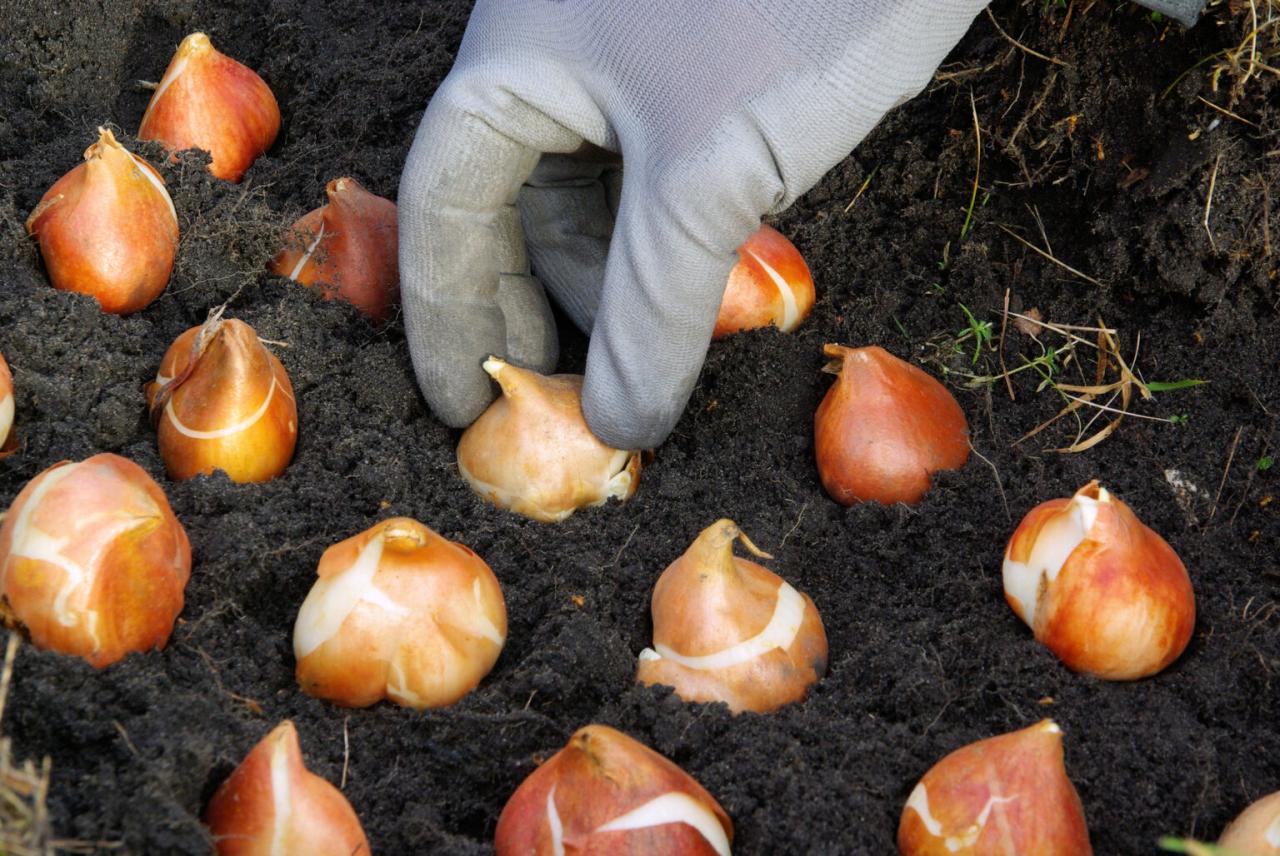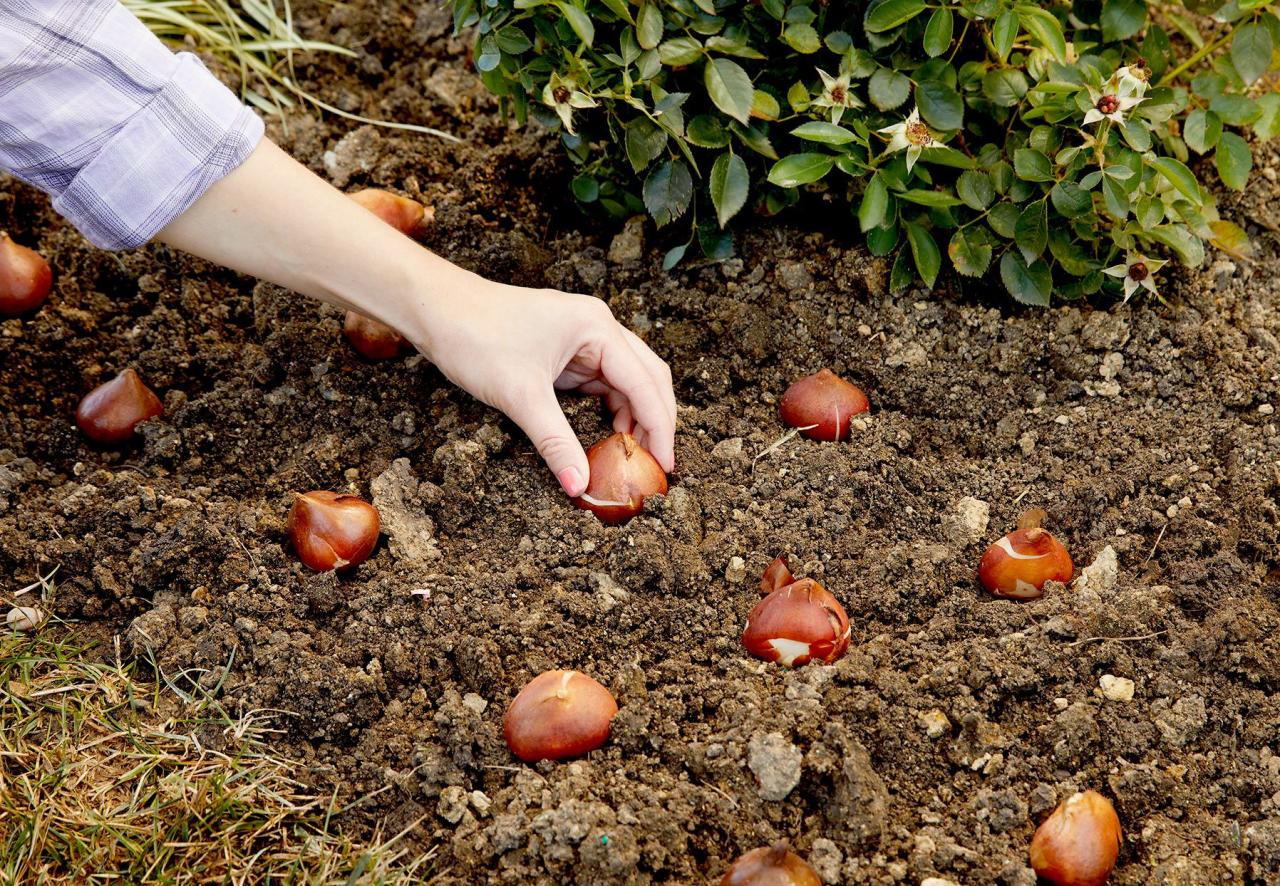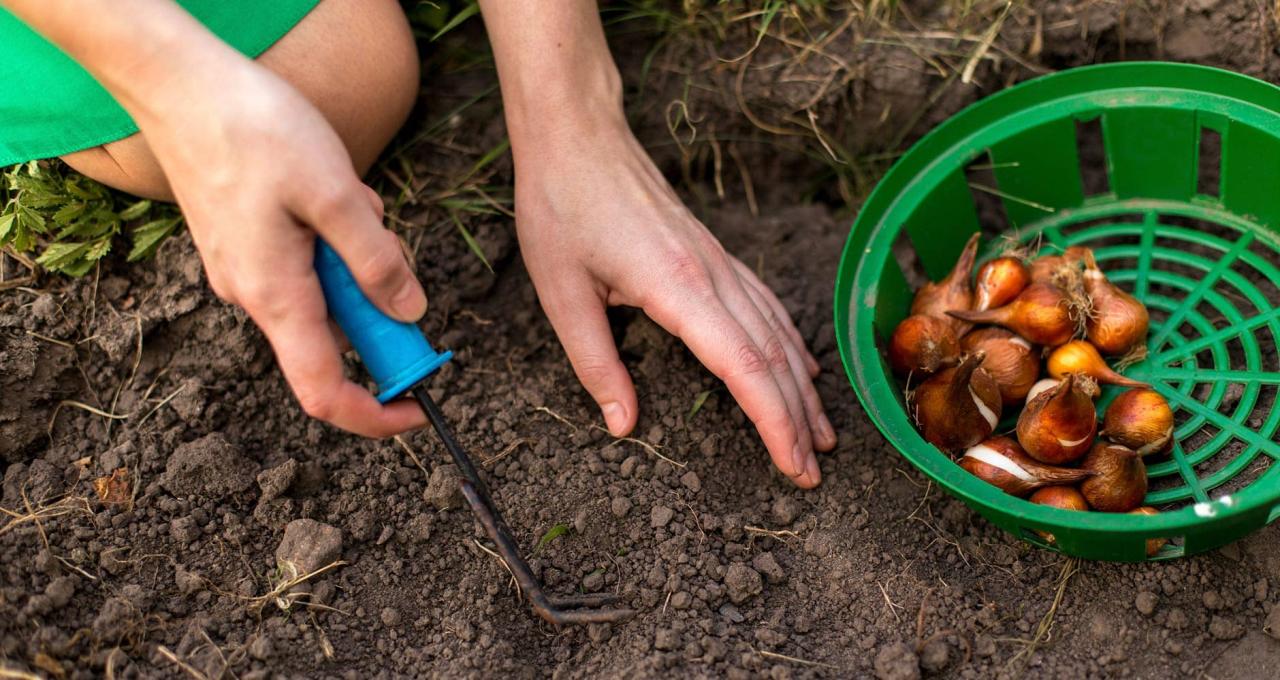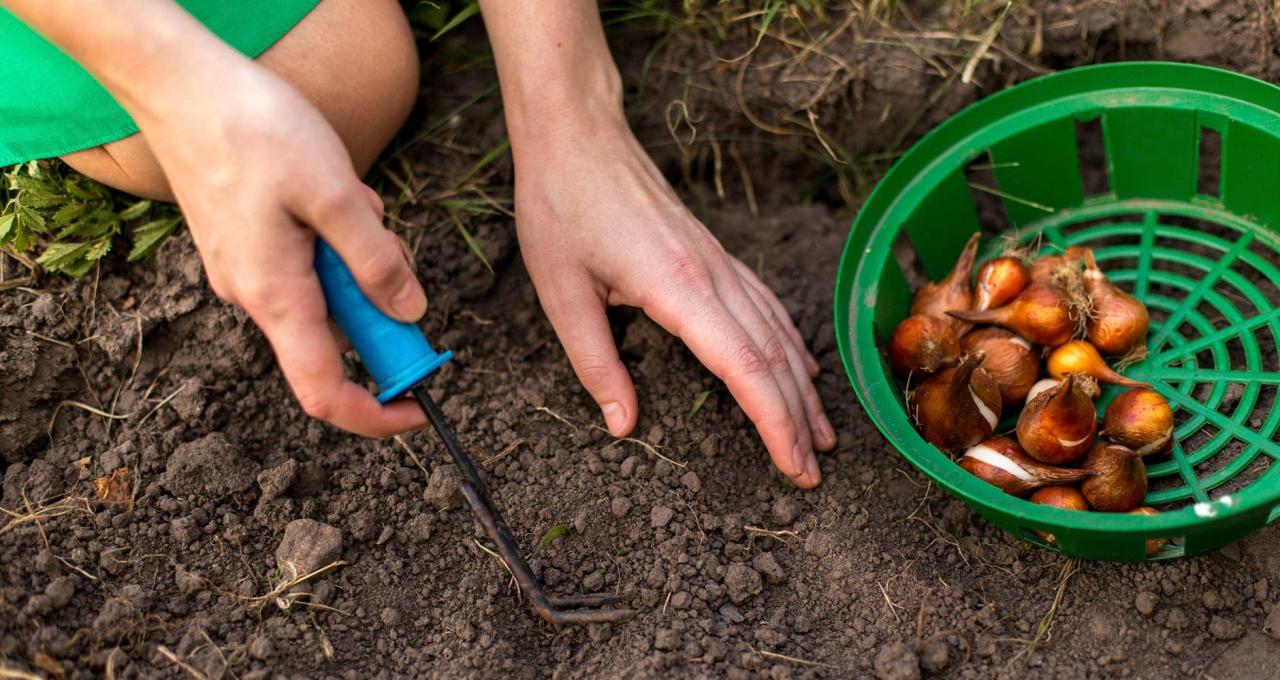The Ultimate Guide To Fall Bulb Planting For Spring Blooms unveils the secrets to transforming your garden into a vibrant tapestry of colors come springtime. Fall bulb planting is an essential practice for any gardener seeking a stunning display of blooms.
This comprehensive guide delves into the art of choosing the right bulbs, preparing the soil, and nurturing them through the winter months, ensuring a spectacular explosion of color come spring.
From understanding the benefits of fall planting to mastering the techniques of bulb care and maintenance, this guide provides a step-by-step roadmap to success. Learn about the diverse range of bulbs available, their unique characteristics, and how to select the perfect varieties for your garden’s specific conditions.
We’ll explore the optimal planting depths, spacing, and soil preparation techniques, ensuring your bulbs thrive and produce an abundance of blooms. Discover the best companion plants to enhance your bulb displays, create visual interest, and attract beneficial pollinators.
Introduction to Fall Bulb Planting

Fall bulb planting is an essential step for a vibrant spring garden. By planting bulbs in the fall, you can enjoy a stunning display of colorful blooms come springtime. This practice allows bulbs to establish their root systems before the cold weather arrives, setting them up for healthy growth and beautiful blossoms.
Choosing the Right Bulbs, The Ultimate Guide To Fall Bulb Planting For Spring Blooms
Selecting the right bulbs for your region and garden conditions is crucial for successful fall planting. Consider factors like your climate zone, soil type, and the amount of sunlight your garden receives. Here are some tips for choosing the right bulbs:
- Climate Zone:Choose bulbs that are suitable for your specific climate zone. Refer to a bulb planting guide or consult with your local nursery for recommendations.
- Soil Type:Bulbs thrive in well-drained soil. If your soil is heavy clay, consider amending it with compost or sand to improve drainage.
- Sunlight Requirements:Most bulbs prefer full sun to partial shade. Choose bulbs that match the sunlight conditions of your garden.
Planting Depth and Spacing
Planting depth and spacing are crucial for bulb success.
- Planting Depth:The general rule of thumb is to plant bulbs at a depth that is two to three times the height of the bulb. For example, a bulb that is 2 inches tall should be planted 4 to 6 inches deep.
- Spacing:Spacing depends on the type of bulb. Smaller bulbs can be planted closer together, while larger bulbs require more space. Refer to the planting instructions on the bulb packaging for specific spacing recommendations.
Popular Fall Bulbs for Spring Blooms: The Ultimate Guide To Fall Bulb Planting For Spring Blooms
Once you’ve chosen your planting site and prepared the soil, it’s time to select the bulbs that will bring a splash of color to your spring garden. With a vast array of options available, you can create a vibrant tapestry of blooms that will delight your senses and attract pollinators.
Popular Fall Bulbs for Spring Blooms
Here’s a table that showcases some popular fall bulbs and their characteristics:
Bulb Type |
Bloom Time |
Color |
Planting Depth |
|---|---|---|---|
Allium (Ornamental Onion) |
Late Spring |
Purple, Pink, White |
6-8 inches |
Crocus |
Early Spring |
Purple, Yellow, White |
3-4 inches |
Daffodil |
Early to Mid-Spring |
Yellow, White, Orange, Pink |
6-8 inches |
Hyacinth |
Mid-Spring |
Purple, Pink, Red, White, Yellow |
6-8 inches |
Iris |
Late Spring |
Purple, Blue, Yellow, White |
4-6 inches |
Lily |
Mid to Late Spring |
Orange, Yellow, Pink, White |
6-8 inches |
Narcissus |
Early Spring |
Yellow, White, Orange |
6-8 inches |
Snowdrop |
Early Spring |
White |
3-4 inches |
Tulips |
Mid-Spring |
Red, Yellow, Orange, Pink, Purple, White |
6-8 inches |
Fritillaria (Fritillary) |
Early Spring |
Purple, Yellow, Red |
4-6 inches |
Allium (Ornamental Onion)
Allium bulbs produce large, spherical flower heads that resemble ornamental onions. They come in various colors, including purple, pink, and white, adding a unique touch to the garden. Allium bulbs prefer well-drained soil and full sun. They attract beneficial insects and deter pests, making them a valuable addition to any garden.
Planning to plant bulbs this fall? Our comprehensive guide, “The Ultimate Guide To Fall Bulb Planting For Spring Blooms,” will help you create a vibrant spring garden. Within this guide, you’ll find a curated list of the best bulbs for early spring blooms, including those highlighted in our article, The Best Bulbs For Early Spring Blooms You Should Plant In Fall.
By following our planting tips, you’ll ensure your bulbs thrive and produce beautiful blooms come springtime.
“Companion plants for Allium include roses, lavender, and salvia, which complement their purple hues and create a visually appealing contrast.”
Crocus
Crocus bulbs are among the earliest bloomers, emerging from the ground in late winter or early spring. They produce delicate, cup-shaped flowers in shades of purple, yellow, and white. Crocus bulbs thrive in well-drained soil and full sun to partial shade.
Planning for a vibrant spring garden starts in the fall with the planting of bulbs. “The Ultimate Guide To Fall Bulb Planting For Spring Blooms” provides a comprehensive overview of this essential gardening practice. To maximize your spring blooms, consider the wide array of bulbs available, from classic tulips and daffodils to lesser-known varieties like fritillaries and alliums.
For inspiration, check out our guide on Spring Flowering Bulbs To Plant In Fall , which explores the diverse options for creating a stunning spring display. With careful planning and a little effort, you can ensure your garden is a riot of color come springtime.
They are a favorite food source for early-emerging pollinators like bees.
“Companion plants for Crocus include other early-blooming bulbs like snowdrops and grape hyacinths, creating a vibrant carpet of color in the early spring.”
Daffodil
Daffodils are a classic spring bloom, known for their cheerful yellow trumpets. They come in a wide variety of colors, including white, orange, and pink. Daffodils prefer well-drained soil and full sun to partial shade. They are deer-resistant and naturalize readily, spreading throughout the garden over time.
“Companion plants for Daffodils include tulips, hyacinths, and alliums, creating a harmonious blend of spring colors and textures.”
Hyacinth
Hyacinths are known for their intensely fragrant, bell-shaped flowers that come in a rainbow of colors. They prefer well-drained soil and full sun to partial shade. Hyacinths are best planted in groups to create a strong visual impact and maximize their fragrance.
“Companion plants for Hyacinths include tulips, daffodils, and alliums, creating a vibrant display of spring blooms.”
Iris
Irises are known for their elegant, sword-shaped leaves and showy flowers that come in various colors, including purple, blue, yellow, and white. They prefer well-drained soil and full sun to partial shade. Irises are a long-lasting bloom, adding color and texture to the garden for several weeks.
“Companion plants for Irises include peonies, roses, and lavender, creating a harmonious blend of colors and textures in the garden.”
Lily
Lily bulbs produce tall, trumpet-shaped flowers in a range of colors, including orange, yellow, pink, and white. They prefer well-drained soil and full sun to partial shade. Lily bulbs are known for their fragrance and are a favorite among gardeners for their elegant appearance.
“Companion plants for Lilies include roses, peonies, and delphiniums, creating a beautiful and fragrant display in the garden.”
Narcissus
Narcissus bulbs produce trumpet-shaped flowers similar to daffodils but with a more delicate appearance. They come in a range of colors, including yellow, white, and orange. Narcissus bulbs prefer well-drained soil and full sun to partial shade. They are deer-resistant and naturalize readily, spreading throughout the garden over time.
“Companion plants for Narcissus include tulips, hyacinths, and alliums, creating a vibrant display of spring blooms.”
Snowdrop
Snowdrops are among the earliest bloomers, emerging from the ground in late winter or early spring. They produce delicate, bell-shaped flowers in shades of white. Snowdrop bulbs thrive in well-drained soil and partial shade. They are a favorite food source for early-emerging pollinators like bees.
“Companion plants for Snowdrops include other early-blooming bulbs like crocus and grape hyacinths, creating a vibrant carpet of color in the early spring.”
Tulips
Tulips are a beloved spring bloom, known for their wide variety of colors and shapes. They prefer well-drained soil and full sun to partial shade. Tulips are best planted in groups to create a strong visual impact and add a touch of elegance to the garden.
“Companion plants for Tulips include daffodils, hyacinths, and alliums, creating a vibrant display of spring blooms.”
Fritillaria (Fritillary)
Fritillaries are unique bulbs that produce bell-shaped flowers with checkered patterns. They come in a range of colors, including purple, yellow, and red. Fritillaries prefer well-drained soil and partial shade. They add a touch of whimsy and intrigue to the garden.
“Companion plants for Fritillaries include other early-blooming bulbs like crocus and snowdrops, creating a vibrant carpet of color in the early spring.”
Troubleshooting Common Bulb Planting Problems

Even with the best intentions, bulb planting can sometimes go awry. Understanding common issues and their solutions will help ensure your spring blooms are vibrant and plentiful.
Identifying and Addressing Common Bulb Planting Mistakes
Common mistakes in bulb planting can lead to a range of problems, from stunted growth to a complete lack of blooms. Understanding these issues and their solutions can help you achieve successful bulb planting.
- Planting Too Deep:Bulbs planted too deep may struggle to reach the surface, resulting in weak growth and fewer blooms.
- Planting Too Shallow:Bulbs planted too shallow can be susceptible to frost damage and may not develop strong roots.
- Incorrect Bulb Orientation:Bulbs should be planted with the pointed end facing up, allowing the sprout to emerge correctly.
- Poor Drainage:Bulbs planted in poorly drained soil can rot, leading to failure to bloom.
- Improper Bulb Storage:Storing bulbs in warm, humid conditions can damage them, reducing their ability to sprout and bloom.
Solutions and Preventative Measures for Bulb Planting Problems
Knowing how to correct common mistakes can help you achieve successful bulb planting and beautiful spring blooms.
- Planting Depth:The general rule of thumb is to plant bulbs at a depth equal to twice the height of the bulb. For example, a bulb that is 2 inches tall should be planted 4 inches deep.
- Bulb Orientation:Ensure the pointed end of the bulb is facing upwards, allowing the sprout to emerge correctly.
- Drainage:Choose a well-drained location for your bulbs. If your soil is prone to waterlogging, consider amending it with compost or sand to improve drainage.
- Bulb Storage:Store bulbs in a cool, dry, and well-ventilated area. Avoid storing bulbs in direct sunlight or in areas with high humidity.
Table Comparing Bulb Planting Mistakes and Remedies
This table provides a concise overview of common bulb planting mistakes and their solutions:
Mistake |
Solution |
|---|---|
Planting Too Deep |
Plant bulbs at a depth equal to twice the height of the bulb. |
Planting Too Shallow |
Plant bulbs at a depth equal to twice the height of the bulb. |
Incorrect Bulb Orientation |
Plant bulbs with the pointed end facing upwards. |
Poor Drainage |
Choose a well-drained location or amend soil with compost or sand. |
Improper Bulb Storage |
Store bulbs in a cool, dry, and well-ventilated area. |
Conclusive Thoughts

As the first signs of spring emerge, your garden will come alive with a symphony of color, thanks to the thoughtful planning and effort you invested in fall bulb planting. Witness the magical transformation of your garden as bulbs burst forth with vibrant hues, creating a breathtaking display that will captivate all who behold it.
By following this guide, you’ll gain the knowledge and confidence to create a stunning spring garden that will be the envy of your neighborhood.
FAQ Corner
What is the best time to plant bulbs in the fall?
The optimal time to plant bulbs in the fall is typically six to eight weeks before the first expected frost in your area. This allows the bulbs to establish roots before the ground freezes.
Can I plant bulbs in containers?
Yes, you can plant bulbs in containers. Choose pots that are at least twice as wide as the bulbs, and ensure they have drainage holes. Use a well-draining potting mix and follow the same planting depth guidelines as for in-ground planting.
What should I do if my bulbs don’t bloom in the spring?
Several factors can prevent bulbs from blooming, including improper planting depth, insufficient sunlight, or pest infestations. Ensure you’re planting at the correct depth, providing adequate sunlight, and taking steps to control pests and diseases. Sometimes, bulbs may need a year or two to establish themselves before blooming.
